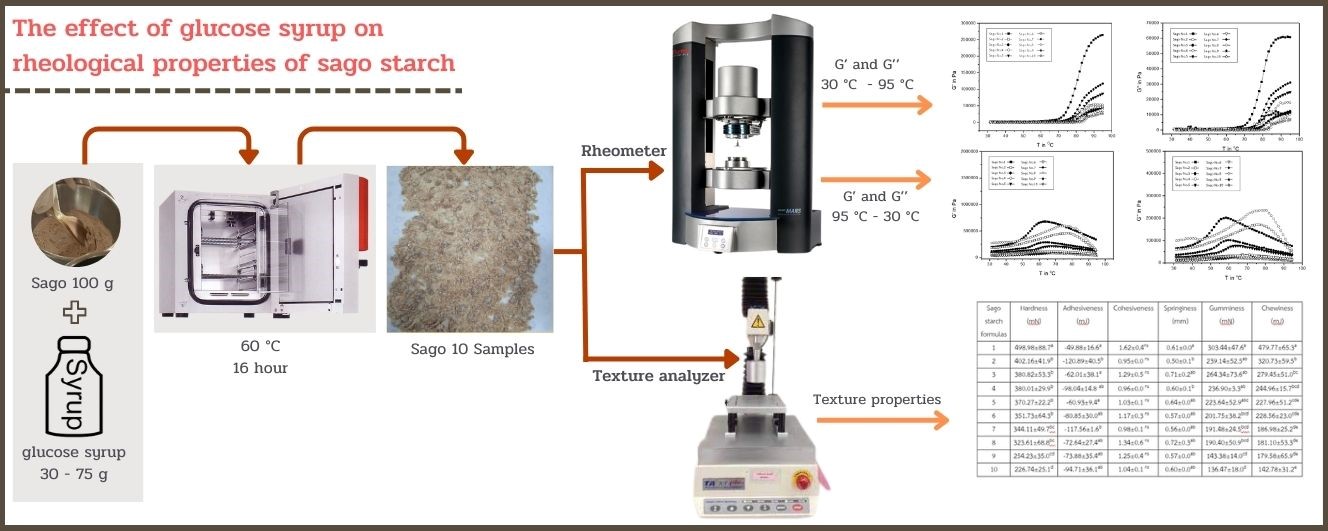The Effect of Glucose Syrup on Rheological Properties of Sago Starch
DOI:
https://doi.org/10.48048/tis.2024.7253Keywords:
Glucose, Glucose syrup, Rheological properties, Sago starchAbstract
The effect of glucose syrup on the rheological properties of sago starch was examined. The glucose syrup (30 - 75 g) was mixed with sago starch 100 g and baked at 60 °C for 16 h. The sago starch formulas 1 - 10 were analyzed rheological properties using a strain sweep test for evaluated Linear Viscoelastic Range (LVR) used for studied temperature test and frequency test. The result showed that the G’ values of the sago starch formulas 1 - 10 decreased respectively which indicated an increase in the amount of glucose syrup resulting in the storage modulus within the starch structure decreasing causing agglomeration. In addition, in the temperature range of 70 - 95 °C, the sago starch formula 1 - 10 began to gelatinize and then stabilize. It indicated that the sago starch slurry was more similar to the solid. When the temperature was lowered from 95 to 30 °C, the G’ and G” values of the sago starch formulas 1 - 10 gradually increased and then decreased because the starch solution during heating is agglomerated into large particles. The flexibility of solids within the powdery structure is very high and very viscous, so that during the initial decrease in temperature, the G’ and G” values increase. After a while, when the temperature inside the structure begins to decrease, which causes the value of G’ and G” to decrease. In the analysis of texture characteristics of the sago starch formulas 1 - 10, it was found that Hardness, Gumminess and Chewiness decreased significantly as the ratio of glucose syrup was increased in the formulations of the sago starch. The lower hardness value of the sago starch formulation with more added content of glucose syrup. Adhesiveness, cohesiveness and springiness values were not different between all the sago starch formulations.
HIGHLIGHTS
- Rheological properties of the sago starch formulas showed that more glucose syrup mixed with sago starch, increased viscoelastic behavior because when increasing the frequency, there will be a value G' > G''
- The different textures of the sago starch formulations indicated the basic action of glucose syrup on the microstructure of the sago starch
- The differences in rheological properties and texture of the sago starch formulas are the reasons for choosing different filling ratios of sago starch and glucose syrup for cooking
GRAPHICAL ABSTRACT
Downloads
Metrics
References
Y Takeda, C Takeda, A Suzuki and S Hizukuri. Structures and properties of sago starches with low and high viscosities on amylography. J. Food Sci. 1989; 54, 77-182.
PA Sopade and K Kiaka. Rheology and microstructure of sago starch from Papua New Guinea. J. Food Eng. 2001; 50, 47-57.
I Khatijag and H Patimah. Physico-chemical properties of local native starches. J. Trop. Agr. Food Sci. 1998; 26, 99-104.
Y Ishii, A Kawabata and M Nakamura. Flow behaviours of tropical starch pastes as measured by a rotational viscometer. Oyo Toshitsu Kagaku J. Appl. Glycosci. 1998; 45, 107-15.
PA Sopade and K Koyama. The effect of fortification with peanut (Arachis hypogea) on the relationship between viscosity and rotational speed of Karamap Saksak, sago-based traditional Papua New Guinean food. New Zealand Food J. 1999; 29, 10-3.
M Nurul I, BMNM Azemi and DMA Manan. Rheological behaviour of sago (Metroxylon sagu) starch paste. Food Chem. 1999; 64, 501-5.
G Wang, X Yan, B Wang, X Hu, X Chen and W Ding. Effects of milling methods on the properties of rice starch and steamed rice cakes. LWT Food Sci. Tech. 2022; 167, 113848.
SL Sim, CG Oates and HA Wong. Studies on sago starch. Part I: Characterization and comparison of sago starches obtained from Metroxylon sagu processed at different times. Starch 1991; 43, 459-66.
S Abd-Aziz. Sago starch and its utilisation. J. Biosci. Bioeng. 2002; 94, 526-9.
FB Ahmad and PA Williams. Rheological properties of sago Starch. J. Agr. Food Chem. 1998; 46, 4060-5.
I Zaidul, A Karim, MA Manan, A Ariffin, N Norulaini and A Omar. Study of rheological profile analysis related to texture for mixtures of sago-wheat gel. Int. J. Food Properties 2002; 5, 585-98.
F Baquer, M Nejatian, S Abbaszadeh and M Taghdir. The effect of gelatin and thymol-loaded nanostructured lipid carrier on physicochemical, rheological, and sensory properties of sesame paste/date glucose syrup blends as a snack bar. J. Texture Stud. 2020; 51, 501-10.
MC Bourne. Food texture and viscosity: Concept and measurement. Academic Press, Cambridge, 2002, p. 1-32.
N Singh, J Singh, L Kaur, NS Sodhi and BS Gill. Morphological, thermal and rheological properties of starches from different botanical sources. Food Chem. 2003; 81, 219-31.
M Okazai. The structure and characteristics of sago starch. In: H Ehara, Y Toyoda and DV Johnson (Eds.). Sago palm multiple contributions to food security and sustainable livelihoods. Springer, Germany, 2018, p. 247-59.
V Vamadevan and E Bertoft. Sturcture-function relationships of starch components. Starch 2015; 67, 55-68.
S Nishiyama, M Okazaki, N Katsumi, Y Honda and M Tsujimoto. Surface charge on sago starch granules. Sago Palm 2016; 23, 77-83.
MM Martines, C Li, M Okoniewska, I Mukherjee, D Vellucci and B Hamaker. Slowly digestible starch in fully gelatinized material is structurally driven by molecular size and A and B1 chain lengths. Carbohydr. Polymer. 2018; 197, 531-9.
C Du, F Jiang, W Jiang, W Ge and SK Du. Physicochemical and structural properties of sago starch. Int. J. Biol. Macromol. 2020; 164, 1785-93.
V Vamadevan, E Bertoft and K Seetharaman. On the importance of organization of glucan chains on thermal properties of starch. Carbohydr. Polymer. 2013; 92, 1653-9.

Downloads
Published
How to Cite
Issue
Section
License
Copyright (c) 2023 Walailak University

This work is licensed under a Creative Commons Attribution-NonCommercial-NoDerivatives 4.0 International License.






